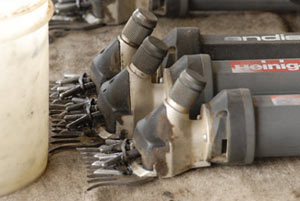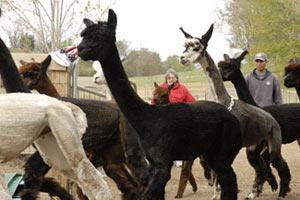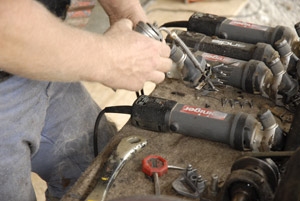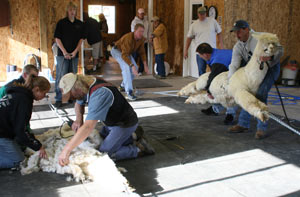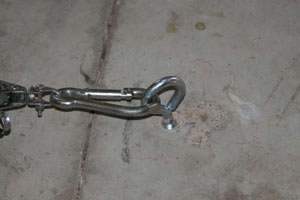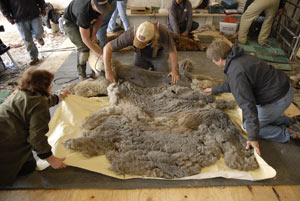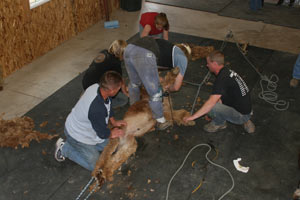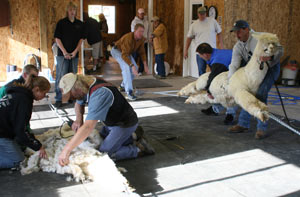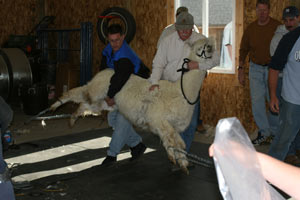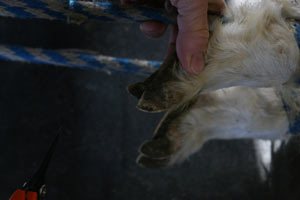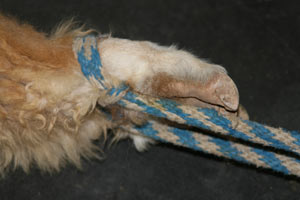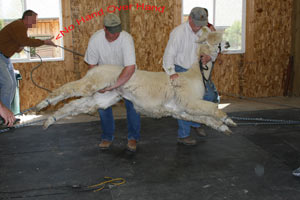 |
|||||||||
| |
|||||||||
| |
|||||||||
| |
|
|
|||||||
 |
|||||||||
 |
|||||||||
Q:Who to call for booking A: Please call Mark. Do not call your shearer as they do NOT do any of the booking. Telephone: 970-682-7976 or Cell: 970-371-2468 Q: Comb and how much fiber is left on A: All our shearers use a Mark-9 comb. This comb is designed to leave ¼ of an inch of fiber on the animal, giving it protection from the sun and cold. The density of each individual animal’s fiber will determine how pink they look. Suris are more prone to look pink as their fiber is a different texture from Huacayas.
Q: Oil usage for the least amount of contamination A: All of our shearers are experienced sheep shearers and the use of oil is just part of the job. You shouldn’t have to worry about any contamination at all. This concern comes from inexperienced shearers putting too much oil on the comb and cutter as they have not yet learned how to set the comb, cutter, and hand piece to prevent overheating, and they tend to take much longer to shear an animal, which will also cause overheating. Therefore, they use too much oil to try and solve the problem.
Q: Sunburn & Cold. A: If it’s going to be cold you can put some straw in your barn and bed your animals. If you don’t have a barn, as long as you have wind protection you can still put some straw down for them to bed down in. Of course, there are always alpaca blankets. Usually the animals will acclimatize within 2-3 days. Sunburn shouldn’t be a problem as the 9 tooth comb leaves enough fiber on for protection.
Q: Using two shearing stations as opposed to one A: Two shearing stations utilize time and make your shearing day work efficiently. Not only do you have time to clean one shearing area whilst the shearer’s working on the other one, (making fleece contamination a non issue), but you also have time to put the next animal to be shorn down slowly, carefully and correctly. This is important especially for the pregnant females. It eliminates rushing so everyone stays calm which really helps the shearers as the animals themselves are calmer and do not struggle so much when it’s their turn to be shorn.
Q: Distances between shearing stations. A: The optimal distance between shearing stations is 6’ (feet). This area is for the shearer only! You are risking serious injury if you invade his space.
Q: Distance for tying off ropes A: The optimal distance is 22’ (feet) between the tie off point of the front & back ropes. If you don’t have a suitable area, there have been some fairly make-shift situations so don’t despair. The shearing can take place outside on suitable flooring i.e. shearing platforms, explained later. The minimal distance you can work safely with is 20’. It’s also very important to have the ropes as low to the ground as possible. No more than 2inches off the ground. You can use eye bolts in the flooring, or wooden posts. This is more comfortable for the animals and also helps prevent the ropes from twisting.
Q: How much time for each animal? A: This depends on the help you manage to get for the day – seriously!! All of our shearers are capable of shearing an animal in under 4 minutes, so if shearing day is taking longer than you expected maybe some more people or job changes among current people working are necessary. If the clippers aren’t running, you aren’t getting any shearing done! Down time between animals lengthens the day unnecessarily. Before shearing starts, talk to your shearer and discuss break times. How many animals would you like to have done before a break? Break times should be about 10min, with the exception of the lunch break. Don’t let anyone escape during these times! You can use these breaks to get organized for the next run: Clean up, change fiber bags, etc. Owners – take this opportunity to talk with your shearer and make sure everything’s running smoothly, and you’re getting the job you want. Q: How many helpers are needed? A: Ok, there needs to be a take down crew of two people to hold the animal. The rope person will be responsible for putting the ropes on the alpaca legs. This crew can also get the next animal, put back the shorn ones, and clean shearing stations. One person to pull the ropes; one person to be the “Fiber Chicken”. This person will work closely with the shearer and he will school you on how, when, and when NOT to grab fiber. Fiber Chickens – Please listen carefully, your fingers are at risk!!! Fiber chickens will also be the Butt person. This will also be explained by your shearer. Generally Mark and our other shearers bring their head-man with them. It’s also very important that once people have started, they remain at their designated job for the rest of the day. This will help your day go by more efficiently and safely. Of course if you’re going to be weighing fleeces and cleaning, you’ll need more help.
Tip – have all of your fleece bags name-tagged before shearing begins. Q: Shearing of Pregnant Females: A: This is one of the most frequently asked questions during booking. Most of the females shorn during the shearing season are pregnant. They have been shorn when they’re over due, on the day they’re due, weeks before etc. If we were to give you a percentage out of the thousands of females that are shorn every season, about 90% are pregnant. Of course, if you still have any questions regarding the health and safety of your pregnant females, you can always talk to your vet or other owner’s who have worked with our shearers in the past.
Q: Shearing of cria: A: Cria shearing is a wonderful thing. Your baby gets rid of the amniotic fluid from his/hers fleece so when you shear them as a yearling you will have a staple without sticky ends. This is, again, a personal choice for all breeders. Ask your shearer when he comes, if you have any babies at that time, to shear them. Yes we do put them down in the ropes: they struggle just as much as an adult. Safety first!! Of course they don’t have to be stretched that hard, but firmly enough to keep them still. Always keep Mother right there so when baby gets up they can re-acquaint with each other. We haven’t heard much feed back of mothers not accepting their baby’s after shearing. Shearing of Suri cria is not as common as Huacayas due to the difference in fleeces. But that doesn’t mean the boys won’t do it. If it has fiber, it’s fair game!
Q: Socks for Spitting and Asphyxiation concerns: A: This approach to eliminate fiber contamination has been very successful. Again, out of the number of animals shorn every season, we have not heard of any trouble with animals asphyxiating. They need to be average length as we all know that these animals can and do seem to produce endless amounts of that lovely green slimy spit. All of our shearers head men are familiar with this procedure and know to keep an eye on whether or not to replace the sock. Not surprisingly, they can fill up. It’s also not a good idea to use socks with holes. I know no explanation is needed. Q: Trimming toenails and giving shots: A: These two things need to be done either before the shearer gets to the animal or after. However you want to work it. Again, here comes the reason for using two sets of ropes. This gives your team time to get this done in a calm fashion. If you’re giving shots before shearing, don’t worry if you see blood after shearing. Giving shots can cause slight bleeding. On the other hand, there is no need to draw blood when trimming toe-nails. It should only take one action for each foot. There is no need to spend time cutting off and shaping the end of the nail. See picture.
Q: How to put animals down safely: A: OK…. This is really important. Whoever you choose to be the put down team MUST be strong and fit!! This is a very physical job – especially if you have Suris. Please try to make sure these people can stay until shearing is done. It’s extremely important for the chosen workers to really pay attention when the shearer and his head man are teaching this technique. There has been many a train wreck, but there doesn’t have to be. When you watch the video it looks easy, but for those of you who have done it, you know it’s hard work. It’s also important not to go grabbing and wrestling the animals. This upsets them and makes it very hard on the shearer and especially the headman. Always try to take a quiet approach and maneuver them gently into position. I know this is hard to do sometimes, but this is why you need strong men for this job. When the animal is down and stretched out, it’s very important to CHECK and make sure the ropes are on correctly. The rope should be right above the fetlock. NOT half way up the leg, and NOT below the fetlock.. This can cause serious injury to the animal.
The “Rope” person is also part of the take down crew and needs to pay attention. He/she needs to check the rope tension every time so it’s not too tight or loose. He/she also needs to RUN when it’s time to pull when taking down an animal and tightening after the shearer does the brisket. Pulling hand over hand is NOT an option. He/she also needs to be paying attention 100% of the time. Slack ropes are dangerous to the animals, shearer, headman and fiber chicken!! He/she also needs to check the ropes for twisting every time. Other workers need to be paying attention so as NOT to be standing chatting in the way of the rope person(not that you should be standing and chatting anyway ^_^).You are looking to be bowled over!!
Owners- It’s very important for you to be present when the “Put Down” demo is happening. We do not want any of your animals to be injured. But it is up to you to keep an eye on what is happening with your animals and your choice of people for help that day. The shearer and his headman are focused on Shearing and cannot be expected to be able to keep an eye on everything that’s going on all the time. That responsibility is Yours.
Q: Taking off Halters A: This needs to be done after the animal is put down and is securely in the ropes, and before the shearer gets to it. Also check for name tags around the neck. These are very hard to shear around, through or over! Halters go back on before ropes are taken off and animals are let up!!!! Q: Holding pens in close proximity to shearing stations; without any bedding: A: You will only be wasting time and energy, for you and the shearer, if your holding pens are too far away. Efficiency is always a plus. No bedding is more for your fiber than the shearer. If you are going to be showing fleeces it’s going to be easier to prep your fleece with less contamination. The ideal situation is to place a pen at either end of the shearing stations. You then have a pen for animals to be held in, i.e., a catch-pen for animals still needing to be shorn, and a release pen for those animals that are finished. Q: Whether or not to blow out fleeces or to vacuum? (To blow, or not to blow?) A: The difference between blowing and vacuuming is the splitting of the fiber staple. Vacuuming is probably better if you intend to show your fleece. Most of the time, you only need to clean the back of the neck and the back. This is where the most contamination occurs. Vacuuming also helps clean off dust and grit which helps the shearer’s equipment immensely. If you are serious about showing you might want to think about getting a wire lattice table. Then when you are ready to prep your fleece, spread it out on the table and a lot of dust and debris will simply fall through the wire to the floor. Q: What can we use if enough help is not available? A: Hopefully this is not an issue. Though we understand that for some of you it is and can be a problem. Really there is no substitute for an extra set of hands on shearing day. If you are short however, it would be greatly appreciated if the shearer knows ahead of time. Yours may not be the only place he will shear ON that day. It also gives him the opportunity to call ahead to other owners if there is an expected delay. Q: Transporting Animals for Shearing Hubs A: You have no idea how much this helps all of us during shearing season. It reduces time spent packing up, setting up and driving between farms. This can add up to many hours wasted in just one day. Of course, we know that not all of you have trailers. For those of you who do and do travel so our shearers don’t have to, we thank you sincerely. The shearers may have to travel up to 30,000 miles in those main shearing months. So any break you as owners can give them, I can assure you, is very much appreciated.
Q: Fiber Samples A: These can be taken during shearing by the Fiber Chicken. This should be agreed upon by the owners before shearing while fiber bags are being readied. So as the animal is being put down the already named bags go next to that station. The sample is then harvested on the first side the shearer shears. Fiber Chickens should know when and where that is. Again, it’s the Owners responsibility to make sure they do. This process will not slow down your shearing day and the sample can then be put in the Blanket bag with the fleece. It’s also up to the owner to do it this way, or to already have the fiber sample taken before shearing. Q: Animal Identification A: Again, owners please make sure you have the animals ID before the shearer gets to it. This can be done in a timely manner once the Put Down Team has the animal secured in the ropes on the station were the shearer is not. This could be a job designated for the rope person. Here is another example of why 2 sets of ropes make shearing day so much easier.
Q: Bio Security A: While the heat generated from grinding to sharpen the gear would take
care of most issues, all our shearers wash their gear throughly. If
however you'd like to take extra measures : foot bathes.e.t.c All of our
Q: Accommodation for Shearers A: This is not expected. All the boys are very grateful if this is a possibility. But again you are not obliged to provide it. If you can and are willing to accommodate the shearer and his head-man, you can let that be known during booking. Again this is greatly appreciated. Q: What to Supply For Meals A: Wholesome foods and lot’s of liquids, such as Water & Gatorade . If you like to have a beer after that’s great (keeping in mind that if the boys have another job to go to they will not be able to drink). Spicy foods are very hard on the shearers because they have to bend over. Might not be very nice for you either!!! Generally lunch time will last an hour. This may vary depending on start time and the amount of animals to be done. Again, be careful no one escapes and goes home. Q: Starting Times A: Clippers should be running at least by 8am. You need to have your crew assembled and ready to go by 7.45am. Owners, make sure everyone knows what job they have been assigned. If they haven’t done it before make sure they are willing to learn!!!! Q: What to shear on A: The ideal shearing surface is a platform. Made up of 3 sheets of ¾ inch plywood, 4x8’ screwed down to 2x4’s. This will give you one shearing station that will measure 8x12 ft. Putting two of these together and running the ropes down the center of each platform gives you the perfect shearing area. It’s also easy to clean. You can also use the interlocking children’s play mats from Sams Club or Wall Mart. The product # is 792076 Reversible Safety Mat. 8 approx. 24" sq. interlocking mats come in one pack for $19.76 per pack. If the flooring is concrete, one could use 11/2 packs of mats per shearing station to make a 6ft x 8ft surface for the alpaca to lie on. The mats are easy to sanitize and take up little more space than a bale of hay.
Note – Alpacas will walk onto these easily as opposed to the blue tarps (so Mark says) and you can still use the platforms outside. If you’re shearing outside, you must provide shade for the shearing area. |
